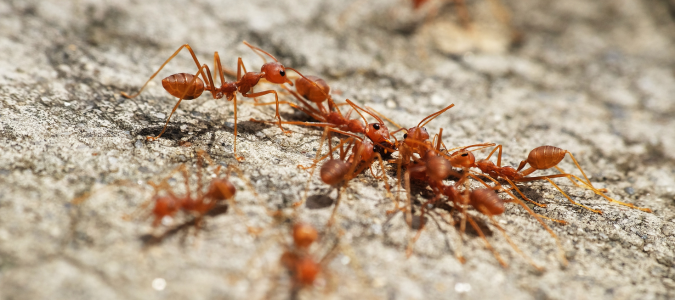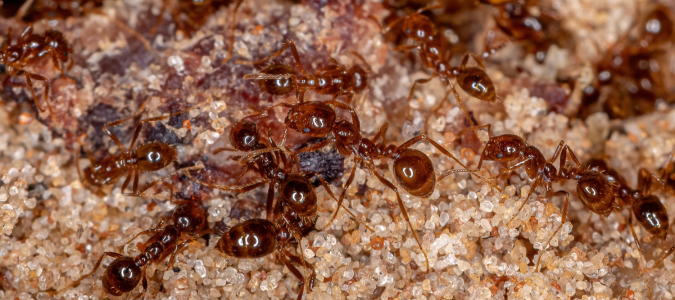With their bites and destructive behaviors, red fire ants are a headache for homeowners. Red fire ants can take over lawns, gardens and sidewalks, building unsightly mounds to grow their colonies.
From their underground fortresses, they march into flower beds, snack on cat food and raid your pantry for anything sweet like honey, syrup or soda. And if you don’t deal with them, their colonies can multiply like crazy.
These insects hate the cold, so they mostly live in warmer climates, where the temperature is just right for nesting. If you’ve seen reddish-brown ants marching in long, determined lines, chances are, red fire ants are making themselves at home. When this happens, it’s time to contact pest control professionals for help controlling red fire ants.
What Do Red Fire Ants Eat?
For starters, red fire ants aren’t picky eaters. Just like the tawny crazy ant, red fire ants will devour almost anything. Their ability to eat just about anything makes them adaptable to many environments. But one thing’s for sure: whether they’re out in the wild or sneaking into your home, these ants are always looking for their next meal.
Here’s a more complete breakdown of what red fire ants eat.
Natural Diet in the Wild
Red fire ants are opportunistic omnivores. They consume animal and plant-based foods, ensuring the colony’s survival and rapid growth.
Live and Dead Insects
Red fire ants primarily feed on other insects, making up a large portion of their diet. These include termites, worms, caterpillars and other types of ants. Their advanced hunting tactics, especially group hunting and swarming behavior, allow them to overpower their targets and hunt even larger prey.
This predatory nature helps them control insect populations and contributes to their dominance in many ecosystems.
Small Animals
Beyond insects, red fire ants occasionally prey on small animals such as lizards, frogs and even baby birds. They use their strong mandibles to latch onto the prey and inject venom through repeated stings. Swarming in large numbers, they quickly overwhelm their target, breaking it down into manageable pieces to bring back to the nest.
Plant Matter, Seeds and Fungi
While primarily carnivorous, red fire ants also consume plant-based foods, including seeds, fruits and nectar. They can damage flowers and other small plants by feeding on their roots, seeds and seedlings.
Additionally, they forage for fungi to supplement their diet when they can’t find their preferred food. Their adaptability to animal and plant-based food sources makes them highly resilient and successful invaders.
What Attracts Red Fire Ants to Homes?
Red fire ants are drawn to homes for their easy food sources. Your leftover food, especially sweets, meats and oils, provides a quick meal for them. They particularly love sugary and greasy foods, which provide the energy they need to build their colonies.
Another reason red fire ants are drawn to homes is trash, compost and pet food. These are easy sources of high-nutrition food that they love. Infestations can quickly occur as red fire ants establish their nests nearby. Seal all of your food waste to help prevent this.
Additionally, moisture is vital for the survival of red fire ants. Leaky pipes, wet soil or water bowls can attract them to your home.
How Do Red Fire Ants Forage for Food
Red fire ants rely on pheromone trails to communicate and locate food. When one ant finds a food source, it releases a chemical signal that guides the other ants to the food.
In a group effort, multiple ants work together to transport food back to the colony. If the prey is too large, they cooperate to break it into manageable pieces and carry it back, often forming chains to move the food efficiently.
Do Red Fire Ants Eat Cat Food?
Red fire ants eat cat food, and they can be a nuisance once they find their way into your pet’s food bowl. Since they’re omnivores, they will eat almost anything, including your cat’s food and other pet food. Cat food is rich in protein and fats, nutrients that red fire ants need, making this dish irresistible.
Here’s why red fire ants love cat food and how to keep them away.
Dry Versus Wet Cat Food: Which Is More Appealing?
Dry and wet cat food can attract red fire ants, but they mostly prefer damp food. Wet food, being moist and often mixed with meat or fish, provides an easy and attractive meal for the ants.
Although less appealing, dry cat food attracts fire ants due to its high protein content. They will readily scavenge both types of cat food, especially if it’s left out for extended periods.
How Red Fire Ants Get Into Pet Food
Red fire ants are resourceful and can find food even in places you think they can’t reach. If your cat’s food bowl is outside, it can become a prime target. Red fire ants will crawl into pet bowls and can easily invade outdoor feeding stations. But they don’t stop there; red fire ants can even find their way indoors if food is left out or stored improperly. Their strong sense of smell allows them to detect food, even from a distance and they will follow pheromone trails to the source.
How to Keep Red Fire Ants Away From Pet Food
Preventing red fire ants from infesting your pet’s food is possible with a few simple steps:
- Store food in airtight containers. Sealing cat food prevents ants from sniffing it out and helps preserve it.
- Don’t leave pet food out overnight. Clean the bowls and store them when not in use.
- Clean up spills and crumbs immediately. Stray pet food or crumbs can attract ants. Also, regularly wipe down areas where food has been.
- Use natural repellents around feeding areas. Spraying natural deterrents, like vinegar or essential oils (peppermint, tea tree or citrus), around food bowls may help keep red fire ants away.
Other Household Foods Fire Ants Love
Red fire ants aren’t picky when it comes to food sources. Along with cat food, they are drawn to:
- Sugary foods: Anything sweet, such as fruit, soda or candy, can quickly attract fire ants.
- Pet food: Dog food, bird seed and other pet-related food products are common targets.
- Greasy and fatty foods: Red fire ants are attracted to oils, peanut butter and greasy foods.
- Crumbs and food scraps: Even the smallest bits of food left on counters or floors can attract these relentless foragers.
Understanding the diets of red fire ants isn’t enough to control them. You must use other methods to control them. When in doubt, contact a pest control professional with the training and experience to deal with them.
How Long Do Red Fire Ants Live?
Red fire ants have varying lifespans depending on their role within the colony. Let’s dive into these a little more.
Queens
Fire ant queens have a long lifespan, often living for several years, sometimes up to seven years. Like the carpenter ant queen, a fire ant queen will lay thousands of eggs in her lifetime to ensure the colony’s growth and survival.
Worker Ants
Workers ants, which perform tasks such as foraging and defending the colony, live for several weeks to a few months. Their lifespan varies depending on their duties and environmental factors. Workers constantly foraging may have a shorter life than those focused on nursing or tending the queen.
Male Ants
Male red fire ants live only a few days, typically just long enough to mate with the queen.
Why Fire Ant Colonies Grow Rapidly
Fire ant colonies can quickly multiply if multiple queens live in the same colonies. This means a single colony can reproduce rapidly and spread to new areas, making infestations difficult to control.
To prevent a small red fire ant problem from escalating, it’s important to reach out to a professional. Early intervention can prevent widespread infestation.
Let the Pros Handle Your Fire Ant Issue
Red fire ants can quickly invade homes and turn your world upside down. Sealing food and maintaining cleanliness are key to help prevent infestations. If fire ant infestations become unmanageable, consult a pest control specialist to address the problem.
ABC Can Treat the Red Fire Ants on Your Property
Discovering a fire ant colony on your property is concerning for many reasons. Fortunately, ABC Home & Commercial Services can help. Our professionals will create a fire ant control plan that leaves you and your family feeling comfortable again. We can even help with other types of ants, like crazy ants.



